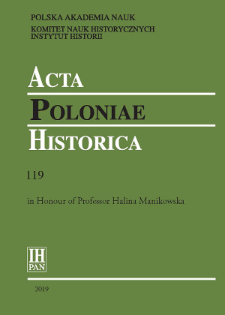- Search in all Repository
- Literature and maps
- Archeology
- Mills database
- Natural sciences
Advanced search
Advanced search
Advanced search
Advanced search
Advanced search

Object
Title: On the Problem of the Size of Trading Complexes in Medieval Towns and Cities of Central Europe
Subtitle:
Acta Poloniae Historica T. 119 (2019), In Honour of Professor Halina Manikowska
Contributor:
Jasiński, Damian : Trans. ; Institute of History of the Polish Academy of Sciences ; Polish National Historical Committee
Publisher:
Instytut Historii im. Tadeusza Manteuffla Polskiej Akademii Nauk
Place of publishing:
Description:
Type of object:
Abstract:
Wherever the town owners did not literally grant the settlement official, i.e. founder (Pol. zasadźca), or the commune itself, full rights to privileged trading facilities, they reserved the competences to shape the size, location and appearance of their complexes. Decisions in this regard formed an element of economic and fiscal policy towards the town, albeit not always – they could also be part of a planned vision of the town or city (the way space was divided could decide about the town’s economy), or flexibly adapted to needs formulated by the interested groups of townspeople. The size of cloth halls and rich stall complexes was supposed to reflect the economic potential of the town, and the size of the complexes of butcher stalls and chambers – the consumption needs of the population. However, in the latter case there were significant deviations, which manifested themselves in strict adherence to artificially established models and traditions rather than in flexibility. The data concerning the number of trade stalls, although still undervalued in historiography, are an important source for research into the history of individual towns and cities, even though they may be less useful for comparative approaches.
References:
Czerner Rafał, Zabudowy rynków. Średniowieczne bloki śródrynkowe wybranych dużych miast Śląska (Wrocław, 2002).
Goliński Mateusz, ‘Die Anfänge der Kaufhäuser und Reichkrame in den schlesischen Städten’, Zeitschrift für Ostforschung, xlii, 1 (1993), 1–20.
Rabęcka-Brykczyńska Irena, ‘Jatki rzeźnicze w Polsce w XIII–XIV wieku’, in eadem and Tadeusz Sobczak, ‘Z problematyki badań nad produkcją i konsumpcją żywności w Polsce’, Studia i Materiały z Historii Kultury Materialnej, lvii (1984), 7–130.
Relation:
Volume:
Start page:
End page:
Detailed Resource Type:
Format:
Resource Identifier:
oai:rcin.org.pl:81806 ; 0001-6829 ; 2450-8462 ; 10.12775/APH.2019.119.06
Source:
IH PAN, sygn. A.295/119 Podr. ; IH PAN, sygn. A.296/119 ; click here to follow the link
Language:
Rights:
Creative Commons Attribution BY-ND 4.0 license
Terms of use:
Copyright-protected material. [CC BY-ND 4.0] May be used within the scope specified in Creative Commons Attribution BY-ND 4.0 license, full text available at: ; -
Digitizing institution:
Institute of History of the Polish Academy of Sciences
Original in:
Library of the Institute of History PAS
Projects co-financed by:
National Programme for the Development of the Humanities
Access:
Object collections:
- Digital Repository of Scientific Institutes > Partners' collections > Institute of History PAS > Serials
- Digital Repository of Scientific Institutes > Partners' collections > Institute of History PAS > Institute Publications
- Digital Repository of Scientific Institutes > Partners' collections > Institute of History PAS > Institute Publications > Journals
- Digital Repository of Scientific Institutes > Partners' collections > Institute of History PAS > Institute Publications > Journals > Acta Poloniae Historica
- Digital Repository of Scientific Institutes > Literature > Journals/Articles
Last modified:
Sep 22, 2023
In our library since:
Oct 1, 2019
Number of object content downloads / hits:
107
All available object's versions:
https://rcin.org.pl./publication/104515
Show description in RDF format:
Show description in RDFa format:
Show description in OAI-PMH format:
| Edition name | Date |
|---|---|
| Goliński, Mateusz (1960- ), On the Problem of the Size of Trading Complexes in Medieval Towns and Cities of Central Europe | Sep 22, 2023 |
Objects Similar
Goliński, Mateusz (1960– )
Goliński, Mateusz (1960– )
Goliński, Mateusz (1960– )
Goliński, Mateusz (1960– )
Goliński, Mateusz (1960– )
Goliński, Mateusz (1960– )
Goliński, Mateusz (1960– )

 INSTYTUT ARCHEOLOGII I ETNOLOGII POLSKIEJ AKADEMII NAUK
INSTYTUT ARCHEOLOGII I ETNOLOGII POLSKIEJ AKADEMII NAUK
 INSTYTUT BADAŃ LITERACKICH POLSKIEJ AKADEMII NAUK
INSTYTUT BADAŃ LITERACKICH POLSKIEJ AKADEMII NAUK
 INSTYTUT BADAWCZY LEŚNICTWA
INSTYTUT BADAWCZY LEŚNICTWA
 INSTYTUT BIOLOGII DOŚWIADCZALNEJ IM. MARCELEGO NENCKIEGO POLSKIEJ AKADEMII NAUK
INSTYTUT BIOLOGII DOŚWIADCZALNEJ IM. MARCELEGO NENCKIEGO POLSKIEJ AKADEMII NAUK
 INSTYTUT BIOLOGII SSAKÓW POLSKIEJ AKADEMII NAUK
INSTYTUT BIOLOGII SSAKÓW POLSKIEJ AKADEMII NAUK
 INSTYTUT CHEMII FIZYCZNEJ PAN
INSTYTUT CHEMII FIZYCZNEJ PAN
 INSTYTUT CHEMII ORGANICZNEJ PAN
INSTYTUT CHEMII ORGANICZNEJ PAN
 INSTYTUT FILOZOFII I SOCJOLOGII PAN
INSTYTUT FILOZOFII I SOCJOLOGII PAN
 INSTYTUT GEOGRAFII I PRZESTRZENNEGO ZAGOSPODAROWANIA PAN
INSTYTUT GEOGRAFII I PRZESTRZENNEGO ZAGOSPODAROWANIA PAN
 INSTYTUT HISTORII im. TADEUSZA MANTEUFFLA POLSKIEJ AKADEMII NAUK
INSTYTUT HISTORII im. TADEUSZA MANTEUFFLA POLSKIEJ AKADEMII NAUK
 INSTYTUT JĘZYKA POLSKIEGO POLSKIEJ AKADEMII NAUK
INSTYTUT JĘZYKA POLSKIEGO POLSKIEJ AKADEMII NAUK
 INSTYTUT MATEMATYCZNY PAN
INSTYTUT MATEMATYCZNY PAN
 INSTYTUT MEDYCYNY DOŚWIADCZALNEJ I KLINICZNEJ IM.MIROSŁAWA MOSSAKOWSKIEGO POLSKIEJ AKADEMII NAUK
INSTYTUT MEDYCYNY DOŚWIADCZALNEJ I KLINICZNEJ IM.MIROSŁAWA MOSSAKOWSKIEGO POLSKIEJ AKADEMII NAUK
 INSTYTUT PODSTAWOWYCH PROBLEMÓW TECHNIKI PAN
INSTYTUT PODSTAWOWYCH PROBLEMÓW TECHNIKI PAN
 INSTYTUT SLAWISTYKI PAN
INSTYTUT SLAWISTYKI PAN
 SIEĆ BADAWCZA ŁUKASIEWICZ - INSTYTUT TECHNOLOGII MATERIAŁÓW ELEKTRONICZNYCH
SIEĆ BADAWCZA ŁUKASIEWICZ - INSTYTUT TECHNOLOGII MATERIAŁÓW ELEKTRONICZNYCH
 MUZEUM I INSTYTUT ZOOLOGII POLSKIEJ AKADEMII NAUK
MUZEUM I INSTYTUT ZOOLOGII POLSKIEJ AKADEMII NAUK
 INSTYTUT BADAŃ SYSTEMOWYCH PAN
INSTYTUT BADAŃ SYSTEMOWYCH PAN
 INSTYTUT BOTANIKI IM. WŁADYSŁAWA SZAFERA POLSKIEJ AKADEMII NAUK
INSTYTUT BOTANIKI IM. WŁADYSŁAWA SZAFERA POLSKIEJ AKADEMII NAUK


































